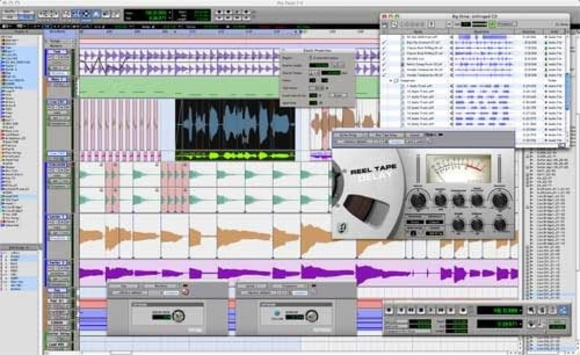5. Audio Recording
Audio recording on a computer is a relatively simple affair these days. Audio tracks are displayed alongside MIDI tracks in the Arrange window, and so the convention of a vertical list of tracks and a horizontal time base has remained. Each track will allow you to select an input from whichever are available on your soundcard simply arm the track(s) for recording, check the levels, and click the record button on the transport bar. As you record, the time-line scrolls along and a visual representation of the wave file is displayed. Modern computers are plenty fast enough to cope with monitoring audio and effects live this may seem an obvious requirement, but not so long ago, delays in the region of half a second between input and output made this impossible.
Digital audio is completely non-linear - to the computer its just data that can be accessed from any point at any time. The fun you used to have of trying to get a tape machine to return to zero is now history, and you can instantly play back from any part of the song. Other common features you can expect to find will allow you to mark two points and seamlessly loop a piece of audio for continuous playback, or just as with text in a word processor, chop up digital audio and move it around, copy it, paste it, loop it and even reverse it. To give a practical example, you could record a couple of bars of a new riff youve been working on, copy and paste it fifty times over, and then play alongside while working out a second guitar part.
A relatively recent innovation is that of multiple-take recording. This allows you to loop your project so that (for example) the chorus plays back over and over for you to sing along to, each loop producing an individual recording. You can then go back and choose the best take, or even better, choose the best parts from different takes and comp them together. With the notable exception of Pro Tools, theres usually no software-imposed limit on audio tracks, so you can keep on experimenting without fear of running out. 250 tracks of CD quality audio are easily achievable on a basic PC with a regular internal hard drive, or if you want to record at 24bit / 96kHz, then youll get about a third as many tracks, so 70 would be a good rule of thumb, or over 100 for two drives in a RAID 0 configuration (see below).

Pro Tools 7.4
Hard Drives
Digital audio is recorded onto hard drives. They are mechanical devices with moving parts, and specifications such as spin speeds and access times. Until a few years ago, the type and speed of hard drive was very important - professionals used SCSI (Small Computer Serial Interface) drives which had the superior speeds needed for serious audio work. These days, SCSI has become more or less obsolete, with regular hard drives now easily capable of the job. A standard internal hard drive will usually have a spin speed of 7200rpm, which is plenty, and if anything, its actually the interface to the computers motherboard that can cause a bottleneck. In recent times, the standard Parallel ATA connection has given way to the faster Serial ATA connection, meaning that newer systems effectively have even faster and better drives.
One way of improving the audio performance of your system is to use RAID (Redundant Array of Inexpensive Disks). This technology was originally designed for servers, but by using the RAID 0 flavour of the specification, we can combine two or more hard drives that are striped into a single high-performance drive - you can generally achieve a 20-40% increase in track count, as well as double the storage space. Its important to note that using two drives in this way does not provide any additional security for your data - if one drive fails you still lose the whole lot. RAID 1 is an alternative method of using two drives together which mirrors the data rather than striping it. Because the same data is written to both drives simultaneously, if one goes down, then you still have a copy. Raid 1 has a negative effect on track count though, and storage space is not increased.
Laptops generally come with smaller and slower 5400rpm hard drives. These are capable of about 40 tracks of 24bit / 96kHz audio which, is still pretty good, and there are some 7200rpm 2.5 laptop drives in existence should you wish to upgrade you basic drive, or specify a custom machine. Secondary external hard drives that connect via USB or FireWire are commonly used to give laptops better audio performance.



